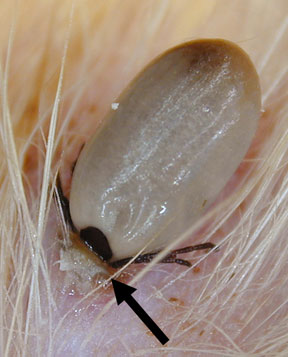First fleas, then lice, and now ticks. I hope nobody reading this gets creeped out by creepy-crawlies. If you need step-by-step instructions on removing ticks, click there. Otherwise, read on!
Ticks are quite prolific on the North Shore and the local islands. The most common ticks we see are Ixodes pacificus and various Dermacentor species. The adults are most active in the spring and fall, though some species are also feeding during the summer.

Western black-legged tick, Ixodes pacificus. From left: nymph, adult male, adult female.
(Photo courtesy Richmond Laboratory, California Dept. Public Health)
So who cares? It's just a tick.
We care about ticks because they are vectors for bacteria like Borrelia burgdorferi, which causes Lyme disease. However, we are blessed to be living in a part of the world where this disease is very uncommon. Ticks from our area are routinely caught and cultured for these bacteria by the BC Center for Disease Control. We (AMH) also submit ticks that we remove from dogs and cats in order to add to the statistical data and to determine whether an animal has been exposed to Lyme disease. A small percentage of these ticks are positive.
Most dogs that are exposed to B. burgdorferi have a transient infection. The tick delivers a small number of bacteria into the body and the animal's immune system looks after it, just as it was meant to do. This is why a lot of dogs will test positive for Borrelia antibodies despite never having had a sick day; the immune system has neutralized the disease, and the pet is (at least temporarily) immune.
Ticks can also cause a serious disorder called tick paralysis. This is a sudden, progressive paralysis that can result in death if not treated. A number of tick species can cause tick paralysis. It is thought to result from a toxin in the tick's saliva. As it happens, we are smack dab in the middle of the region with the highest incidence of tick paralysis in North America. Treatment consists of removing the tick and supportive care. Most animals recover completely once the tick is removed.
Life and Times
Ticks, like other creepy crawly critters, go through a series of stages in their development. A tick hatches from a tiny egg as a tiny 6-legged larva (called a "seed tick") less than 1 mm across, about the size of the period at the end of this sentence. The larva attaches to a host and feeds for about a week before dropping off to digest its meal, after which it molts into an 8-legged nymph. The nymph finds another host and feeds for a week or longer, then drops off again to digest its bellyful of blood, which takes about a month. It then molts again and becomes an adult tick.
The adult tick enters into a long life of seeking out a host (only one host as an adult), feeding, dropping off and digesting. Mating generally occurs on a host, while one partner is feeding. Female ticks will lay up to 8,000 eggs at a time. Ticks can go a long time without food, and can enter a sort of hibernation state if they need to overwinter or wait until conditions are more favorable to feed.
Questing
Ticks have specialized organs called Haller's organs on the first set of legs, which detect carbon dioxide (like in exhaled breath) and heat. The front legs also have a set of barbed hooks, made for clinging to things. When it is feeling peckish, a tick will climb up onto a grass blade or shrub and hang on with its back legs. The tick waves its front legs out in front of it as it clings to the grass, "sniffing" the air and hoping to sense a passing animal. When something warm and CO2-ish goes by, the tick grabs onto the hair with its barbed legs and hangs on. This leg-waving behavior is known as "questing". Contrary to popular mythology, ticks do not drop out of trees.
 Feeding
Feeding
Ticks are dull eaters. Where horseflies tear out a chunk of flesh and use their sponge-like mouthparts to sop up the blood, ticks just shove their mouthparts into the skin. There are barbs on the mouthparts, too, which help to anchor them into the skin and makes them difficult to accidentally remove as their victim gets on with life. Hard ticks (like those common here) also secrete a type of "cement" that seals the hole and literally glues their mouthparts into the host. This cement dissolves when the tick is finished feeding.
The mouthparts are used like a straw, and the tick sucks up blood. In the process, it will also regurgitate some blood and stomach contents back into the host. This is when bacteria like Borrelia burgdorferi are transmitted.
Disease transmission
At any of the life stages (larva, nymph or adult) the tick can pick up disease-causing bacteria from a host. The bacteria then live and multiply (for the most part) in the stomach of the tick. When the tick goes through its next stage and has to take another meal, the bacteria in the stomach can get "backwashed" into the next host. Gross, eh?
It takes 24-36 hours before this is possible in most circumstances. The tick's stomach has to become somewhat engorged with blood before the regurgitation can occur.
Therefore, check your dog for ticks every day if you are in an area with a large tick population. If you find a tick, have it removed as soon as possible. Do not wait for the tick to drop off. You can greatly decrease your dog's risk of contracting Lyme disease or tick paralysis by being vigilant.